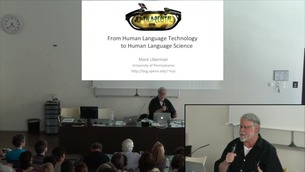Notice
Conférence invitée de Christian Chiarcos Corpora and Linguistic Linked Open Data: Motivations, Applications, Limitations
- document 1 document 2 document 3
- niveau 1 niveau 2 niveau 3
Descriptif
JEP-TALN-RECITAL 2016 - Mardi 5 juillet 2016
Conférence invitée
Corpora and Linguistic Linked Open Data: Motivations, Applications, Limitations
Christian Chiarcos
Résumé : Linguistic Linked Open Data (LLOD) is a technology and a movement inseveral disciplines working with language resources, including NaturalLanguage Processing, general linguistics, computational lexicographyand the localization industry. This talk describes basic principles ofLinguistic Linked Open Data and their application to linguisticallyannotated corpora, it summarizes the current status of the LinguisticLinked Open Data cloud and gives an overview over selected LLODvocabularies and their uses.A resource constitutes Linguistic Linked Open Data if it is publishedin accordance with the following principles:
- The dataset is relevant for linguistic research or NLP algorithms.
- The elements in the dataset should be uniquely identified by meansof a URI.
- The URI should resolve, so users can access more information usingweb browsers.
- Resolving an LLOD resource should return results using webstandards such as Resource Description Framework (RDF).
- Links to other resources should be included to help users discovernew resources and provide semantics.
- Data should be openly licensed using licenses such as the CreativeCommons licenses.
- Representation: Linked graphs are a more flexible representationformat for linguistic data
- Interoperability: Common RDF models can easily be integrated
- Federation: Data from multiple sources can trivially be combined
- Ecosystem: Tools for RDF and linked data are widely available underopen source licenses
- Expressivity: Existing vocabularies help express linguistic resources.
- Semantics: Common links express what you mean.
- Dynamicity: Web data can be continuously improved.
- representing highly interlinked corpora (e.g., multi-layercorpora, annotated parallel corpora),
- integrating corpora with lexical resources available from the webof data,
- facilitating annotation interoperability using terminologyresources available from the web of data, and
- streamlining data manipulation processes in a modular anddomain-independent fashion.
Criterion (1) defines linguistic(ally relevant) data,criteria (2-5) define linked data, criterion (6) defines open data, their combination thus yields Linguistic Linked Open Data.The primary benefits of LLOD have been identified as:
I specifically focus on linguistically annotated corpora and discussthe potential of Linked Data in relation to four standing problems inthe field:
These aspects will be discussed in relation to two selected resourcesfrom both general linguistics and Natural LanguageProcessing. Finally, the talk will discuss some of the challenges thatLLOD is still facing in both areas.
Dans la même collection
-
Conférence invitée de Mark Liberman - From Human Language Technology to Human Language Science
LIBERMAN Mark
From Human Language Technology to Human Language Science


